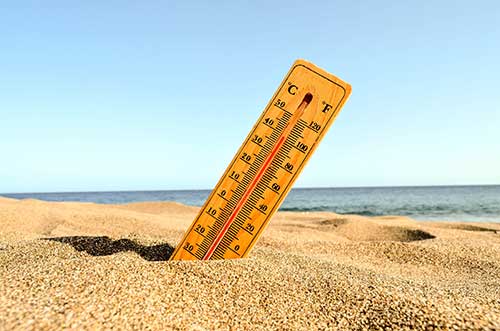What is Heat Stroke

Humans are capable of significant heat generation. Strenuous exercise can increase heat generation twentyfold. This heat generation is well balanced by a variety of heat dissipation mechanisms which are controlled by a central thermostat, which is located in the pre-optic nucleus of the anterior hypothalamus and central nervous system. Thus, normally body dissipates heat into the environment by:
-> Evaporation
-> Radiation
-> Conduction
-> Convection
Heat emergencies are classified based on symptoms as:
-> Heat cramps
-> Heat stress
-> Heat stroke
-
Heat CrampsHeat Stress (Exhaustion)Heat Stroke
-
Muscle crampsSymptoms seen in heat cramps plus:Symptoms seen in heat stress (exhaustion) plus:
-
Normal to mildly elevated temperatureNormal to elevated temperature (<40°C[<104°F])Elevated temperature (>40°C[>104°F])
-
SweatingNausea, vomiting, headache, malaise, dizziness orthostatic hypotensionNeurologic abnormalities: inappropriate behavior, confusion, delirium, ataxia, coma, seizures, Anhidrosis or sweating
Heat stroke reflects a total loss of thermoregulatory function. This is a life-threatening condition if left untreated. Cardinal features include hyperthermia (temperature >40°C [or] >104°F) and altered mental status.
The central nervous system is the most vulnerable, particularly in a heat stroke. The cerebellum is highly sensitive to heat. That is why ataxia is an early neurological finding. Other symptoms include irritability, confusion, bizarre behaviour, combativeness, hallucinations, seizures and coma.
There are no specific diagnostic tests for heat stroke. It is mainly determined by careful history and clinical presentation along with the exclusion of other diagnoses.
-
Differential Diagnosis of Heat Stroke
-
Infection1 – Sepsis
2 – Meningitis
3 – Encephalitis
4 – Malaria
5 – Typhoid
6 – TetanusEndocrine1 – Thyroid storm
2 – Pheochromocytoma
3 – Diabetic ketoacidosisNeurologic1 – Hypothalamic bleed/ infarct
2 – CVA
3 – Status epilepticusToxicologic1 – Anti cholinergic toxidrome
2 – Sympathomimetic overdose
3 – Salicylate overdose
4 – Serotonin syndrome
5 – Malignant hyperthermia
What Should I Do?
- Remove the patient from the hot environment immediately and call for HELP (044 4000-6000).
- Start cooling by removing clothing and spraying water and providing airflow over the patient.
- Place wet towels/ice over the patient body.
- Elevate feet.
What Do We Do?
We aim for immediate cooling and aggressive support of organ system function.
- Check vital signs, measure core temperatures and sugar levels.
- Administer IV fluids at a rate that ensures adequate urine output.
- Control seizures with benzodiazepines.
- Cooling techniques.
Evaporative Cooling:
Cooling by evaporation. We anticipate shivering, which is treated with short acting benzodiazepines.
Immersion Cooling:
Placing the patient in a tub of ice water deep enough to cover the extremities while keeping the patient’s head out of water. More effective for young individuals.
Invasive Cooling Measures:
Cold water gastric lavage, urinary bladder lavage, cold water rectal lavage up to extent of doing cold water peritoneal lavage and cardiopulmonary bypass.
We target a core body temperature of <102°F.
What Are the Complications?
Heat stroke can have both early and delayed complications which include the following:
-
Complications of Heat Stroke
-
Vital SignsEarlyHypotension
Hypothermic overshoot
Hyperthermia reboundLate -
MuscularRhabdomyolysis
-
NeurologicDelirium/coma
SeizureCerebral edema
Encephalopathy
Persistent neurologic deficit -
CardiacHeart failureMyocardial injury
-
PulmonaryPulmonary edemaARDS
-
RenalOliguriaRenal failure
-
GIIntestinal infarction
Pancreatic injury
Hepatic dysfunction -
MetabolicHypokalemia
Hypernatremia
HyponatremiaHyperkalemia
Hypocalcemia
Hyperuricemia -
HematologicThrombocytopenia
DIC
What Are the Poor Prognostic Indicators of Heat Stroke?
- Initial temperature >107.6°F/>42°C
- Acute renal failure
- Massively elevated liver enzymes
- Significant hyperkalemia
- The number of dysfunctional organ systems correlate directly with mortality risk
What Should I Do to Prevent Heat Stroke?
- Decrease or reschedule strenuous activity for cooler parts of the day.
- Wear light and loose-fitting clothing.
- Increase carbohydrate intake and decrease protein intake to decrease endogenous heat production.
- Drink plenty of fluids, even when not thirsty.
- Avoid alcoholic beverages.
- Use salt tablets as well as fluids.
- Avoid direct sunlight.
- Take advantage of the shade.


